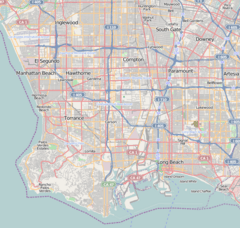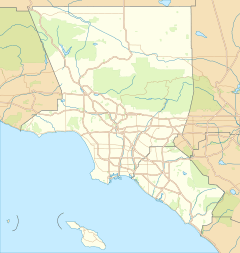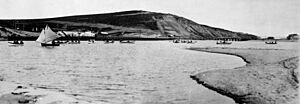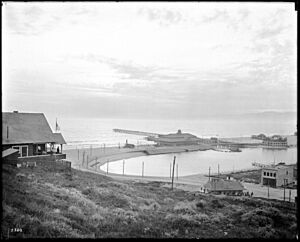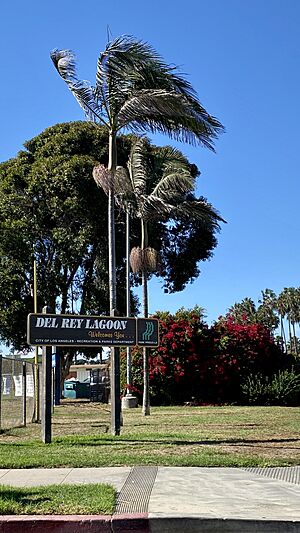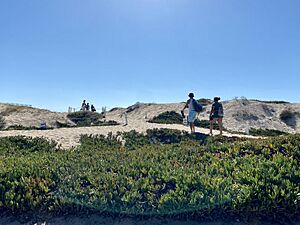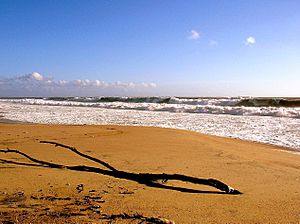Playa del Rey, Los Angeles facts for kids
Quick facts for kids
Playa del Rey
Palisades Del Rey
|
|
|---|---|
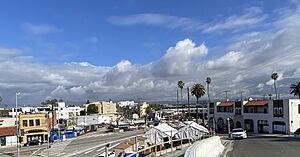 |
|
| Country | |
| State | |
| County | Los Angeles |
| City | Los Angeles |
Playa del Rey means "Beach of the King" in Spanish. It's a cool neighborhood right by the ocean in Los Angeles, California. It's part of the Santa Monica Bay area. In 2018, about 16,230 people lived there.
Contents
What is the History of Playa del Rey?
The lower part of Playa del Rey used to be a large wetland area with sand dunes. Over time, people built walls to control flooding. This created the Ballona Creek, which is a river that flows into the ocean.
Who Lived in Playa del Rey First?
Thousands of years ago, the Tongva people lived in these wetlands. They used the area for fishing and collecting shellfish. They even used special wooden boats called te'aats to travel to the Channel Islands. A major village called Guashna was located here and was an important trading spot.
How Did Playa del Rey Develop?
In the 1870s, people tried to build a harbor in Santa Monica Bay at Playa del Rey. They spent a lot of money to dig out Port Ballona Harbor for shipping goods. But winter waves caused flooding, and the harbor project didn't work out. What was left became the Del Rey Lagoon, which is now a public park.

In 1902, a new development called Playa del Rey began. People could take a streetcar to see the land. In 1910, the Playa del Rey Motordome was built. It was the world's first track made of wood, used for bike and early car races.
The original neighborhood, started in 1921 by Dickinson & Gillespie Co., was called Palisades del Rey. They advertised it as the last undeveloped coastal land in Los Angeles. Many famous Hollywood actors and producers, like Cecil B. Demille, built custom beach homes here.
More homes were built in Playa del Rey starting in 1928. This included the Del Rey Hills neighborhood. Also, Loyola University (now Loyola Marymount University) moved nearby, which helped the area grow.
What Happened to Surfridge?
The southern part of the original Playa del Rey development, known as Surfridge, is now empty. Between 1966 and 1975, houses there were moved or torn down. This was done to make space for the expansion of Los Angeles International Airport (LAX). The noise from the many jet planes also made it hard to live there. The city bought all the homes. Today, you can only see empty land with old streets where houses once stood. This area is now a protected home for the endangered El Segundo blue butterfly.
What About Surfing in Playa del Rey?
In the 1950s and early 1960s, Playa del Rey was a famous surfing spot. However, many rock walls called jetties were built to stop beach erosion. These jetties changed the waves, and now there isn't much good surf left. A small part of the beach is still called Toes Over Beach by local surfers. Most surfers now go to El Porto or Venice Beach.
One thing to be careful about at the beach is water runoff from the creek. Sometimes, there are also emergency water releases from the giant Hyperion treatment plant nearby. Normally, this plant sends treated water far out to sea. But if there's an emergency, water might be released closer to shore, which can affect the beach.
What is "The Jungle"?
Locals call a small area of homes close to the beach "The Jungle." This nickname came from a group of apartments built in 1956. The small paths between the homes had lots of green plants growing, making it look like a jungle.
Today, the Pacific Avenue Bridge connects Playa del Rey to the area near Ballona Creek and the Marina. You can walk or bike across this bridge, but cars cannot. This bridge is the only way for people to cross Ballona Creek between the ocean and Centinela Avenue.
Both the University of California, Los Angeles and Loyola Marymount University have rowing teams. They practice on the Ballona Creek channel and in Marina del Rey.
Where is Playa del Rey Located?
Playa del Rey is a coastal neighborhood in Los Angeles. It's part of an area known as Silicon Beach, which has many tech companies. Because it's very close to Los Angeles International Airport, some people who live there experience air and noise pollution from the airport. Over the years, the airport has expanded, causing many residents to move and homes to be torn down.
Playa del Rey is surrounded by the Pacific Ocean to the west. To the north are Marina del Rey and Ballona Creek. The Ballona Wetlands and Playa Vista are to the northeast. Westchester is to the east, and Los Angeles International Airport and El Segundo are to the south.
Los Angeles has three small parks in Playa del Rey: Del Rey Lagoon Park, Titmouse Park, and Vista Del Mar Park. Del Rey Lagoon Park is about 14 acres (57,000 m2) big and has a shallow saltwater pond called Del Rey Lagoon. This pond is about 5 acres (20,000 m2) in size and about 5 ft (1.5 m) deep. Its depth changes with the tides because it's connected to the Ballona Creek by an underground pipe.
Playa del Rey has rolling hills and wetland ponds. These were formed by ancient sand dunes that were blown by the wind and compacted. These dunes can be as high as 125 feet (38 m) above sea level. They run along the coast from Playa del Rey all the way south to Palos Verdes.
Who Lives in Playa del Rey?
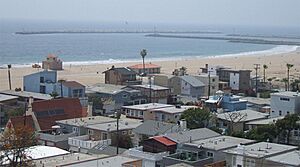

According to the Los Angeles Times, most people living in Playa del Rey are White (72.6%). Other groups include Asian (7.7%), Black (3.9%), and Latino (10.0%).
Most people who work in Playa del Rey (94.7%) have white-collar jobs, meaning they work in offices or professional fields. A large number of adults (65.6%) have at least a bachelor's degree, and many (39.8%) have even higher education. In 2021, the average price for a house here was over $3 million, and the average income was $148,296. This makes it one of the wealthiest areas in Los Angeles.
What is the Economy Like in Playa del Rey?
Playa del Rey is in the middle of Silicon Beach, so its economy is mostly driven by technology companies. Many people who work for airlines and aerospace companies also live here because it's so close to LAX. Most of the land in Playa del Rey is for homes. It's known for its big houses with ocean views. However, most people live in apartments and condos in the eastern part of the neighborhood. Only a few streets, like Manchester Avenue, Pershing Drive, and Culver Boulevard, have businesses like restaurants and offices mixed with homes.
What About Education in Playa del Rey?
Playa del Rey is part of the Los Angeles Unified School District.
Some notable schools in the area include Westchester Enriched Sciences Magnets (for grades 6–8) and St. Bernard High School, which is a private Catholic school.
Since 2014, parents in Playa del Rey can send their children to schools in the Wiseburn School District if they get special permission.
Who are Some Famous People from Playa del Rey?
Many well-known people have lived in Playa del Rey, including:
- Roseanne Barr, actress and comedian
- Charles Bickford, film and TV actor
- Mel Blanc, famous voice actor (the voice of Bugs Bunny!)
- Jerry Buss, former owner of the Los Angeles Lakers basketball team
- Jamaal Wilkes, a Hall of Famer for UCLA and the Los Angeles Lakers
- Bruce Campbell, actor
- Dave Draper, bodybuilder and TV host
- Sam Elliott, actor
- Anthony Michael Hall, actor
- Phil Jackson, former coach of the Los Angeles Lakers
- Anissa Jones, actress
- Noel Jones, a bishop
- Laura Karpman, composer
- Jack Kruschen, actor
- Patrick Long, racing driver
- Benny Mardones, singer/songwriter
- William C. deMille, film director
- Sugar Shane Mosley, former World Champion boxer
- Lenda Murray, professional bodybuilder
- Taylour Paige, dancer and actress
- Tara Reid, actress
- Dawn Robinson, original member of the group En Vogue
- Carroll Shelby, famous car designer
- Carmen Twillie, actress and singer
- Donda West, mother of hip-hop artist Kanye West
See also
 In Spanish: Playa del Rey (Los Ángeles) para niños
In Spanish: Playa del Rey (Los Ángeles) para niños


